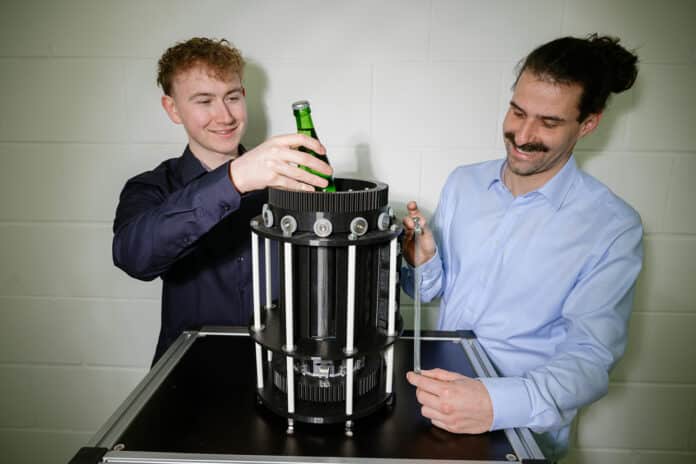A team of researchers at Saarland University and the Center for Mechatronics and Automation Technology (ZeMa) has developed the world’s first refrigerator cooled with artificial muscles made of nitinol, a nickel-titanium alloy. The refrigerator is a small, compact prototype showcasing the new cooling technology.
The technology is based on a simple principle of removing heat from a space by stretching wires and releasing them again. These shape-memory wires are called ‘artificial muscles‘ and are made of super-elastic nitinol. They absorb heat in the cooling chamber and release it to the outer environment.
“Our elastocaloric process enables us to achieve temperature differences of around 20 degrees Celsius without using climate-damaging refrigerants in a far more energy-efficient manner than today’s conventional technologies,” explains Professor Stefan Seelecke, who conducts research at Saarland University and the Saarbrücken Center for Mechatronics and Automation Technology (ZeMa).
The efficiency of elastocaloric materials is more than ten times that of today’s air conditioning systems or refrigerators. The US Department of Energy and the EU Commission have recognized the cooling technology developed in Saarbrücken as the most promising alternative to existing processes. This technology can potentially extract heat from much larger spaces and supply heat to much larger spaces.
Heat transfer via the superelastic wires works for heating applications as well. With climate change, energy shortages, and the growing demand for cooling and heating, this process represents a highly promising solution for the future.
Researchers are using nitinol wires and their shape memory property to transport heat. These wires can remember their original shape and revert to it even after being stretched or deformed. This gives them the ability to flex and contract like muscles and even tense and relax. Nitinol has two solid phases that can transform into each other, unlike water, which has three phases. During these phase transitions, the wires can absorb and release heat, which is intensified when bundled together due to their larger surface area.
Professor Paul Motzki, who heads the Smart Material Systems research group at Saarland University and ZeMa, explains that the shape-memory material releases heat when it’s stretched and absorbs heat when it’s released. The effect is intensified when numerous wires are bundled together – due to their larger surface area, they absorb and release more heat.
Constructing a cooling circuit may seem simple at first, but in reality, it involves highly complex research questions. Currently, a research team is presenting a mini-fridge that uses a specially designed cam drive to continuously rotate bundles of nitinol wires around a circular cooling chamber.
The wires are mechanically loaded on one side, stretched, and unloaded on the other as they move in a circle. Air is channeled past the rotating bundles into the cooling chamber, and the wires absorb heat from the air as they are unloaded. The air then circulates continuously around unloaded wires in the cooling chamber. The wires transport heat out of the cooling chamber as they continue to rotate and release it when stretched outside the cooling chamber.
According to Nicolas Scherer, who is conducting research on the project as part of his Master’s thesis, the cooling chamber cools to around 10-12 degrees Celsius using this method.
The engineers in Saarbrücken are conducting research on how to keep the wires moving continuously, the ideal air flow, and the most efficient processes. They have also developed software that can be used to adjust heating and cooling technology for various applications and simulate cooling systems. They are also researching the entire cycle from material production to recycling and production.
“We want to leverage the innovative potential of elastocalorics in a wide range of applications, such as industrial cooling and electric vehicle cooling, to advance e-mobility and household appliances,” explains Paul Motzki.
The new technology is the result of extensive research spanning over a decade. The research was funded by the EU and the German Research Foundation, among others, and the Federal Ministry of Education and Research has invested more than 17 million euros in the DEPART!Saar project. The goal of the project is to create new technology transfer formats and speed up the process of getting the technology to the market. The engineers have also developed a cooling and heating demonstrator that showcases how elastocalorics can cool and heat air.
